Appendix O. Part 2—Disinfection/Sterilization Record Keeping: Facilitator Notes
Implementation Guide
Slide 1: Appendix O. Part 2: A Clear View of Flexible Endoscope Processing: Disinfection/Sterilization Record Keeping
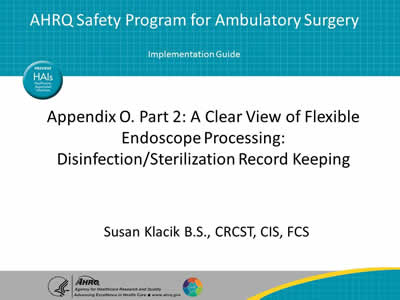
Hi, and welcome to Part 2 of A Clear View on Flexible Endoscope Processing. In this part, we are going to talk about disinfection and sterilization record keeping and also storage of flexible endoscopes.
Slide 2: Objectives
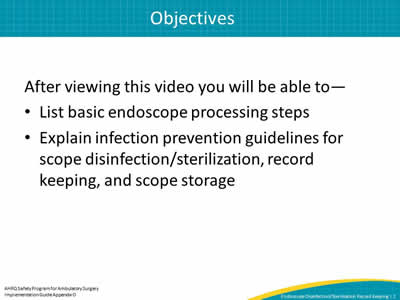
The objectives, after viewing this video, you will be able to list basic endoscope processing steps and explain infection prevention guidelines for scope disinfection/sterilization, record keeping, and scope storage.
Slide 3: High-Level Disinfection/Sterilization: Instructions for Use (IFU)
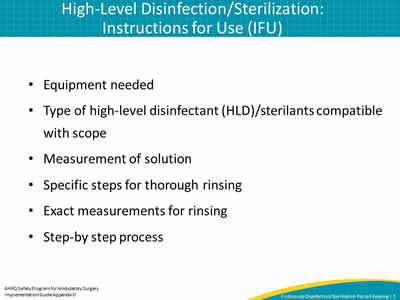
First, we're going to talk about high-level disinfection/sterilization looking at the instructions for use from the medical device manufacturer, which in this case is the flexible endoscope. The flexible endoscope manufacturer has performed validation testing with their flexible endoscope to make sure that the chemicals introduced to the scope, as outlined in their IFU, are safe for the scope. Meaning that, the chemicals will not damage the scope, they won't leave any residue on the scope, and that they will provide the required lethality for the scope to make it safe for the next patient's use. They will also provide the measurement of the solution, provide specific steps for thoroughly rinsing. Rinsing is extremely important, because the disinfectant is toxic, and we don't want any toxic residue getting onto our patient. It provides the exact measurements for rinsing to make sure that all of the high-level disinfectant is removed from the inner channels of the flexible endoscope. The instructions for use will provide step-by-step processes.
Slide 4: High-Level Disinfection
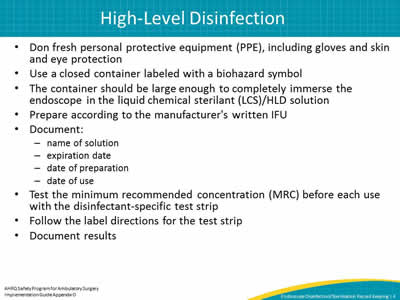
When performing high-level disinfection, we need to don fresh PPEs, and that includes protection of our skin and eyes. We need to use a closed container that is labeled with a biohazard symbol. We need to ensure that the container is large enough to completely immerse the flexible endoscope in the high-level disinfectant. None of the scope can be out of the disinfectant. The liquid chemical sterilant or high-level disinfectant solution needs to be prepared according to that manufacturer's instructions for use. The chemical sterilant or high level disinfectant manufacturer will provide us instructions on how to use it as far as a contact time, or if there's any solution preparation that needs to be performed.
When doing this, we need to document the name of the solution, the expiration date, the date of preparation, and date of use. Prior to each use, we need to test the solution for the minimum recommended concentration per, once again, the high-level disinfectant manufacturer, before use. We want to make sure that the high-level disinfectant, is in fact, effective in that when we place the scope into the solution, that it will provide lethality from the bacterium. To do that, there are specific types of disinfectant test strips available.
So, you need to go back to that manufacturer of the disinfectant and ask them, what type of testing device can I use for this solution to make sure that it is effective for use. Follow the label directions for the test strip. On the test strip bottle they provide specific instructions how to use it, how long to keep it in the solution, how to tell if it's a path or a no path, and also on the instructions for use, you will see, once it's opened, the test strips may only be good for a certain amount of time. On the test strips, they may also have you perform quality checks. Perhaps you do three checks of the test strip in 100 strength and then three tests of the test in a 50 percent solution. So, you need to follow what that manufacturer says and document all these results.
Slide 5: Automatic Endoscope Reprocessor (AER)
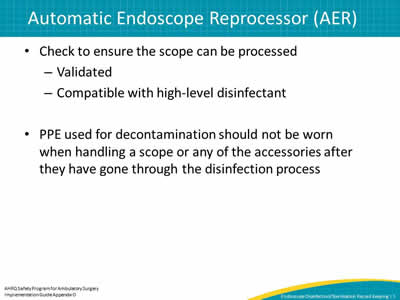
If you're using an automatic endoscope reprocessor or an AER, you need to make sure that the scope can be processed in that, so go back to the flexible endoscope manufacturer and make sure that the scope is compatible with that AER, and also that it's compatible with the high-level disinfectant. The PPE used for the disinfection decontamination should not be worn when handling a scope or any of the accessories that have undergone disinfection. The reason being, the PPEs that were used in the decontam process are now considered as contaminated. So, when we go to remove the flexible endoscope from the AER, the scope is now high-level disinfected. It has a different type of integrity to it. So, after high-level disinfection, we certainly don't want to recontaminate the scope. The recommendation is that when the AER cycle has finished, before removing the flexible endoscope, we need to change our PPEs so that we have fresh PPEs on, so when we remove the scope, we're removing it with clean, non-latex gloves and a clean barrier, so that we do not contaminate the scope.
Slide 6: Automatic Endoscope Reprocessor (AER)
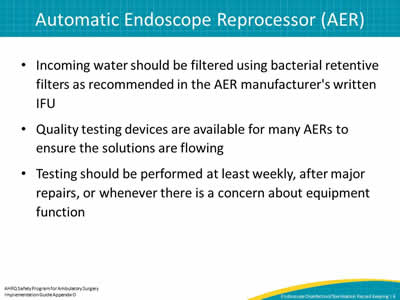
Automatic endoscope reprocessor or AER. When using the AER, it's important to make sure that we use the correct type of water. So, when you're looking for an AER, if you're in the process of purchasing one, make sure that you consult with the AER manufacturers that you have the right type of water quality. Also, the water quality is a very large component of quality processing. So, we want to make sure that the water coming in is filtered using bacterial retentive filters as recommended in the AER manufacturer's instructions for use.
There are now quality testing devices for AERs to make sure that we're getting the correct amount and type of solution flow. These testing devices can actually provide us users with information on the AER if it is, in fact, providing the correct type of solution flow, that we're getting contact to all inner surfaces of the flexible endoscope. This testing should be performed at least weekly, and after major repairs or whenever there's a concern about equipment malfunction.
One of the concerns is that as the scope sits in the AER, and it's going through all the cycles, we want to make sure that we're getting the correct type of solution through. Also, we want to make sure that the solution is effective, so that if the detergent is empty, we want to make sure that we pick up on that. These test kits can make sure that we are doing that. It could be, too, that there may be a kink somewhere in the tubing system, so these new testing devices, again, they will pick up on that. They actually mimic a flexible endoscope’s internal channels, so we can see that we are getting solution to all areas of the internal channel of the flexible endoscope.
Slide 7: Sterilization
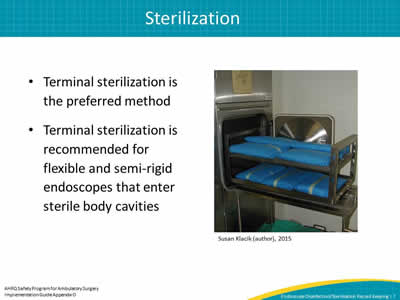
Sterilization. Terminal sterilization is the preferred method. However, it's not always possible. Terminal sterilization is recommended for flexible and semi-rigid endoscopes that enter sterile body cavities.
Slide 8: Storage IFU
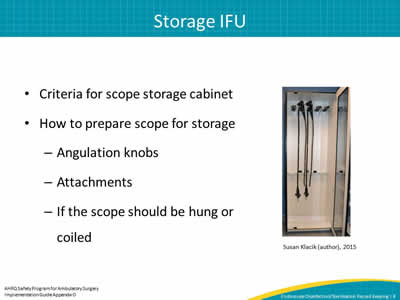
The storage instructions for use, when we're reviewing our instructions for use from the manufacturer, they're going to talk about the criteria for scope cabinets and how to prepare the scope for storage. They'll talk about the angulation knobs, where they should be, the attachments, and if the scope should be hung or if it should be coiled.
Slide 9: Storage ST91
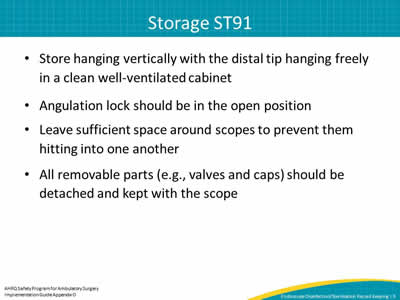
When looking at the AAMI ST91 document on storage, they get very much more involved in the storage, providing more detail and guidance. In the AAMI ST91 document, it talks about hanging the scope vertically with the distal tip hanging freely in a clean, well-ventilated cabinet. In talking about the angulation lock, should be in the open position, and leaving sufficient space around scopes to prevent them from hitting into one another. Also, all removable parts should be detached and, once again, kept with the scope, because they are now kept as one complete component, the scope and the attachments.
Slide 10: Storage ST91
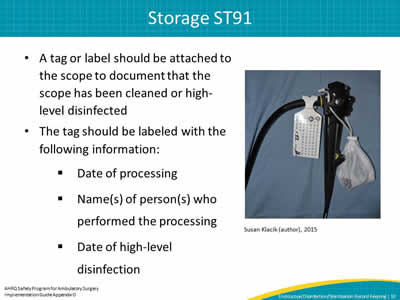
In the AAMI ST91 document, it talks about keeping the attachments with the scopes, and not in a cup or in a drawer within the department. They have to be kept with the scope. Also, a tag or label should be attached to the scope to document that the scope has been cleaned or high-level disinfected. That prevents any confusion or errors of somebody taking a scope, and assuming that it had been through the cleaning process when it really hasn't been. By labeling the scopes, it lets the user know that the scope has gone through the cleaning process and the disinfection process, and that it is, in fact, ready for use. In this picture here, you also see a bag holding the accessory pieces. Now, the tag should be labeled with the following information, and again it should be attached to the scope: the date of processing, the name of the person who performed the processing, and the date of the high-level disinfection.
Slide 11: Storage ST91
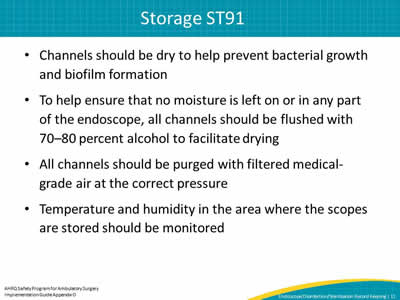
For storage, the channels should be dry to help prevent bacterial growth and the formation of biofilm. In the words of many experts, especially microbiologists, when they talk about the scope being dry, they refer to it as being bone dry because we want to prevent the formation of biofilm and also prevent bacterial growth.
To help ensure that no moisture is left on or in any part of the endoscope, the channels should be flushed with 70-80 percent alcohol to facilitate drying. All channels should also be purged with filtered medical grade air at the correct pressure. That's a very important part. When using the medical-grade air, if the PSI is too high, you can actually blow out the channels of the scope. If it's too low, you're not going to be blowing out these solutions. Contact the manufacturer's instructions for use, and see what the correct PSI is. When storing the scopes, it's important to monitor also the temperature and the humidity in the area where the scopes are stored, so that we make sure that we're storing them in the right environment.
Slide 12: Hang Time
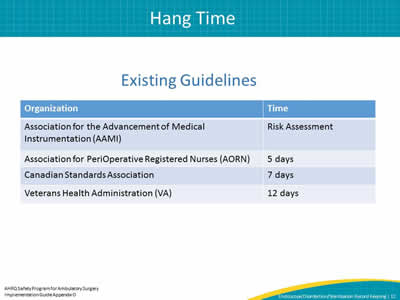
Hang time is a really big issue now. At the time of this presentation, AAMI has recommended that a risk assessment be performed. AORN, at this point, had a 5 days hang time. Canadian Standard’s 7 days, and the Veterans Association [Administration] had 12 days. What AAMI is recommending, is that we perform a hang time risk assessment.
Slide 13: Hang Time Risk Assessment
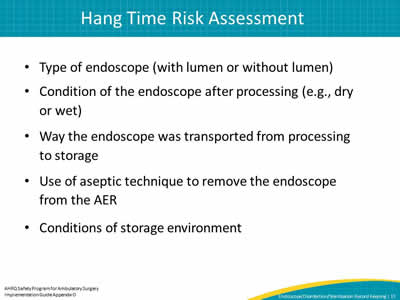
The risk assessment is based on the type of scope, if it has lumen or if it doesn't have a lumen, the condition of the scope after re-processing. In other words, can we thoroughly dry the flexible endoscope. How the endoscope was transported from processing to storage. So, if the scope was handled properly from when it left the AER to storage, it's going to have a longer shelf life than a scope that is transferred in a contaminated manner. Using aseptic techniques to remove the endoscope from the AER, and also the conditions of the storage environment. The storage environment should be clean and well lit, and have plenty of air circulation.
Slide 14: Hang Time Risk Assessment
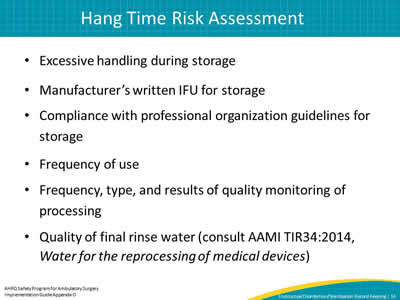
There should not be excessive handling during storage. The scope should be hung in this cupboard. The concern is that if personnel start to look for scopes, that they start to handle the scopes. As the scopes are handled, they can actually become contaminated just from the bacteria of personnel's hands. The recommendation is that after the scope has undergone high-level disinfection, that non-latex gloves are used to handle the scopes. That prevents the bacteria from the caregiver's hands going on to the scope. The manufacturer's IFUs for storage should also be followed. Compliance with professional organizations for storage, their frequency of use of the flexible endoscopes, their frequency, type, and results of quality monitoring during the processing. Also, very important is the quality of the final rinse. AAMI also has a TIR on water. It's AAMI TIR34, and that is for the water for the reprocessing of medical devices. It is a great guide to provide us health care givers instructions on the type of water to use when processing medical devices.
Slide 15: Transport of Disinfected Scopes
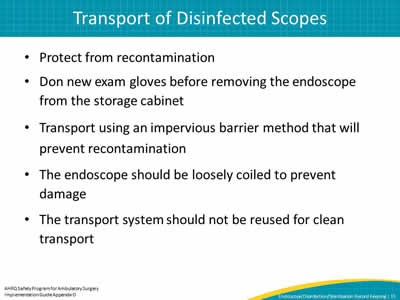
Transporting the scopes to the patient. After the scope has been thoroughly cleaned, disinfected, and protected from recontamination in storage, we need to continue to protect the scope. As we're transporting the scope to the patient, we need to don new exam gloves before removing the endoscope from the storage cabinet. At this point in time, it is recommended that anytime we touch the flexible endoscope after it has undergone high-level disinfectant, that it is always handled with non-latex gloves to prevent bacteria from our hands contaminating the flexible endoscope. The scope should then be transported using an impervious barrier method that will prevent recontamination.
As the scope is removed from storage going to the patient, we do not want to contaminate the scope with any environmental contaminants. Again, what we're going to do is, we're going to protect it. We're going to place it in a barrier so that it cannot get contaminated by environmental contaminants. The endoscope should be loosely coiled to prevent damage. The transport system should not be reused for clean transport.
Slide 16: Quality Control Ability To Track Scope Use
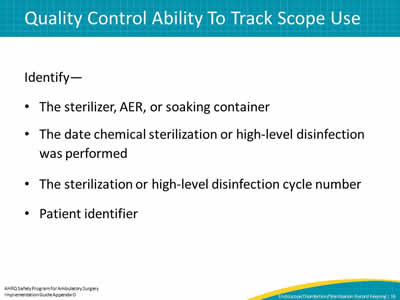
For quality control, ability to track the scope use, some of the documentation. We need to identify the sterilizer, AER, or soaking container that the flexible endoscope was processed in, the date the chemical sterilizer or high-level disinfection was performed, the sterilization or high-level disinfection sterilizer number, and the patient identifier. Patient identifier doesn't necessarily mean a patient name. It could just be a patient number.
Slide 17: Record Keeping
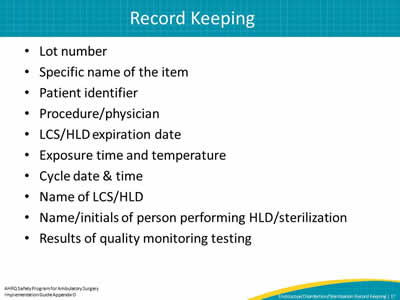
Record keeping. When processing flexible endoscopes, there's a lot of record keeping involved. The first is the lot number, the specific name of the item, the patient identifier, (the patient identifier is not necessarily a patient name, it could be a patient record), the procedure and the physician, the liquid chemical sterilant or the high-level disinfectant's expiration date, the exposure time and temperature of the disinfection process, the cycle date and time, the name of the liquid chemical sterilant or high-level disinfectant, the name or initials of the person performing the disinfection, and the results of all of the quality monitoring testing.
Slide 18: References
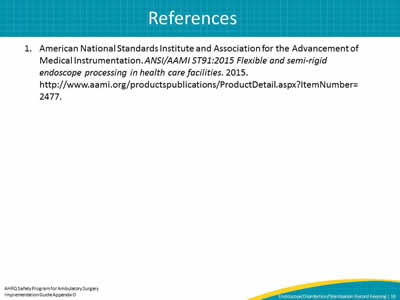
This concludes part 2 of the flexible and semi-rigid endoscope reprocessing. References used for this presentation are from the ANS/AAMI ST91 flexible and semi-rigid endoscope reprocessing in health care facilities. It's a great resource that all facilities should have, in addition to following specifically the instructions for use from the scope manufacturers.



